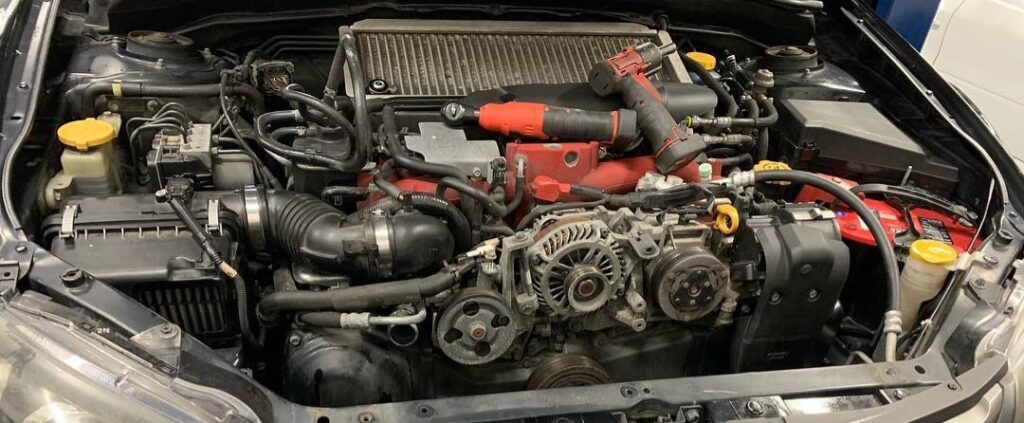What Happens When The Water Pump Goes Out

The water pump, a seemingly unassuming component, is the lifeblood of your engine's cooling system. Its failure can quickly escalate from a minor inconvenience to a catastrophic engine meltdown. Understanding what happens when a water pump goes out is crucial for any car owner, enthusiast, or professional mechanic. Let's delve into the mechanics, symptoms, and preventative measures surrounding this vital piece of automotive engineering.
The Heart of the Cooling System
At its core, a water pump is a simple centrifugal pump, driven either directly by the engine's crankshaft via a belt (serpentine or V-belt) or indirectly via a timing belt. In some modern vehicles, especially hybrids and electric vehicles with range extenders, you might find electrically driven water pumps allowing for on-demand cooling and better efficiency. Regardless of the drive mechanism, its job is the same: to circulate coolant (a mixture of water and antifreeze) throughout the engine block, cylinder head, and radiator.
This circulation is critical for dissipating the intense heat generated by combustion. Without proper cooling, engine components like pistons, valves, and cylinder heads can overheat, leading to warping, cracking, and ultimately, complete engine failure. Think of it like a human heart: without constant circulation, vital organs shut down.
Signs of a Failing Water Pump
Recognizing the warning signs of a failing water pump can save you significant money and prevent serious engine damage. Here are some common symptoms:
- Overheating Engine: This is the most obvious and critical sign. The temperature gauge will climb rapidly, potentially reaching the red zone. Ignoring this can lead to a blown head gasket or worse.
- Coolant Leaks: A puddle of green, orange, or pink fluid (depending on the type of coolant used) beneath your car, especially near the front of the engine, is a strong indicator of a leak. The water pump itself is a common leak point, especially around the weep hole.
- Whining or Grinding Noises: As the water pump bearings wear out, they can produce a distinct whining or grinding noise, especially when the engine is cold. This noise will often increase with engine RPM.
- Visible Steam: If you see steam emanating from under the hood, it could be a sign of coolant boiling due to a lack of circulation caused by a failing water pump.
- Low Coolant Level: Constantly needing to add coolant to the reservoir is another red flag. This indicates a leak somewhere in the cooling system, and the water pump should be inspected.
The Chain Reaction of Failure
When a water pump fails, the consequences can be far-reaching. Here's a breakdown of the potential cascade of events:
- Reduced or No Coolant Circulation: The pump stops effectively circulating coolant through the engine block and radiator.
- Engine Overheating: Without proper cooling, the engine temperature rises rapidly, exceeding safe operating limits.
- Component Damage: Excessive heat can cause damage to various engine components, including the head gasket (leading to coolant mixing with oil), cylinder head (warping or cracking), pistons (scoring), and even the engine block itself.
- Potential Catastrophic Engine Failure: In the worst-case scenario, the engine can seize completely due to overheating, resulting in irreparable damage and requiring a complete engine replacement.
Water Pump Replacement: A Preventative Approach
Most manufacturers recommend replacing the water pump as part of routine maintenance, often coinciding with timing belt replacement (if the engine uses a timing belt-driven water pump). This proactive approach can prevent unexpected failures and costly repairs down the line. The lifespan of a water pump varies depending on the vehicle and driving conditions, but a good rule of thumb is to consider replacement around 60,000 to 100,000 miles.
The cost of replacing a water pump can range from a few hundred to over a thousand dollars, depending on the vehicle make, model, and the complexity of the job. For example, replacing a water pump on a Subaru WRX, which often requires significant disassembly due to its boxer engine configuration, will typically be more expensive than replacing one on a more conventional inline-four engine.
When replacing the water pump, always use a quality replacement part from a reputable manufacturer like Aisin, Gates, or Bosch. Additionally, it's crucial to flush the cooling system and refill it with the correct type of coolant specified for your vehicle. Using the wrong coolant can lead to corrosion and further damage to the cooling system.
Beyond the Pump: Inspecting Related Components
While replacing the water pump, it's also wise to inspect other cooling system components, such as the thermostat, radiator hoses, and radiator cap. A faulty thermostat can restrict coolant flow, contributing to overheating issues. Worn hoses can crack and leak, and a malfunctioning radiator cap can prevent the system from maintaining proper pressure. Replacing these components concurrently can prevent future problems and ensure optimal cooling system performance.
In conclusion, a functioning water pump is absolutely essential for maintaining the health and longevity of your engine. By understanding the signs of a failing pump and taking a proactive approach to maintenance, you can prevent costly repairs and ensure your vehicle continues to run smoothly for years to come.
